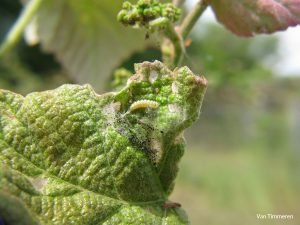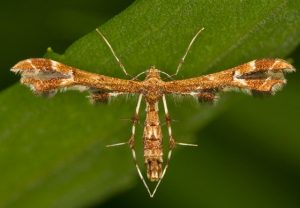Grape Plume Moth

Grape plume moth may start showing up in vineyards soon, though it is a sporadic insect in vineyards in the Midwest. The characteristic injury is caused by the larvae webbing together the terminal leaves on a shoot to protect themselves from predators and parasitoids while feeding on the tender leaves. Peak infestation usually occurs around the end of May into early June in southern Wisconsin. While in some years, such as 2016, there may be quite a few larvae present at sites, the vines generally recover fairly well, and grape plume moth rarely reaches damaging levels that would warrant an insecticide application.
The larvae are light green spindle-shaped with long white hairs (Fig. 1). They are most easily identified by looking for the characteristic webbed up leaves on the tip of the grape vine; however, these webbed areas should be opened and the larva positively identified to be grape plume moth, as other insects can cause similar webbing in grapes. The adults are brown and white striped, with a feathery look to them (Fig. 2).

Adults emerge in the early spring and lay eggs on the underside of young leaves. When they hatch, the caterpillars feed on the upper surface of grape leaves, and sometimes on the terminal bud. Older caterpillars may bore into the plant’s stem or flower buds, which may impact yield. The caterpillars will then drop off the leaves and burrow underground to pupate by mid-summer and overwinter, resulting in one generation per year.
Monitoring should focus on the perimeter rows nearest to woodlands, looking for the webbed terminal leaves on shoots. The caterpillars may begin to appear in late spring and will have pupated by the time the fruit is setting.
Generally grape plume moth does not cause enough damage to require control. Research has shown that vines with up to 20% infested shoots do not show reduced yield (Cornell). A simple cultural control is to remove the affected leaves and caterpillars. If you experience a high infestation and decide to apply an insecticide, you will find that grape plume moth is not mentioned in the Midwest Fruit Pest Management Guide. As grape plume moth is a leafroller, products registered for grape berry moth should also be efficacious on grape plume moth. In organic production, Pyganic, Entrust, Grandevo or Venerate should provide some form of control.
Happy growing season!
This article was posted in Insects and tagged Christelle Guédot, grape plume moth, Grapes, insects, Janet van Zoeren.
